
DETROIT – Engineers at General Motors’ new brake testing facility know the differences between moans, squeals, grinds, groans and grunts – annoying noises common to their work.
Now, with a new brake chassis dynamometer, they can simulate braking in weather conditions that range from Alaska to a tropical island.
With the new facility opened earlier this year, GM vehicles can now take up to 1,900 stops in 2½ days compared with 1,000 stops in two weeks using previous testing methods. The result is a quiet braking experience that customers associate with a quality vehicle.
“If we do our job correctly, the customer won’t notice our work,” said Brent Lowe, GM performance engineer for brake noise development. “Watch any movie and you’ll hear brake squeal every time a car stops because Hollywood loves to add the brake squeaking sound effect, and nothing bugs me more. We work to make sure our brakes lead the industry in silence.”
The new dynamometer was developed in conjunction with supplier Link Engineering. The state-of-the-art facility can run 24 hours a day, simulate underbody airflow, and change temperatures and humidity.
“The ability to control and replicate the conditions that our customers’ vehicles are driven under is just as important as the ability to control the brake pressure, vehicle speed and direction,” Lowe said.
 GM’s 14,000-square-foot test chamber is padded with jagged sound proofing to provide a quiet environment for testing, and the room room can replicate vast changes in climate, temperature and moisture conditions.
GM’s 14,000-square-foot test chamber is padded with jagged sound proofing to provide a quiet environment for testing, and the room room can replicate vast changes in climate, temperature and moisture conditions.“The concept of a silent brake is actually very complicated,” said Lowe. “Braking creates friction and the more friction present amounts to more noise. Though the sound of brakes squealing is something every driver can easily identify as a nuisance, it is one of the more difficult things to actually remove. We have been very successful at taking on that challenge at GM.”
Before the new facility, the team had to rely on test driving vehicles at the track and a two-wheel drive chassis dynamometer that offered far less control over humidity and temperature.
“With our previous methods and equipment, we became really good at finding and mitigating approximately 85 percent of existing brake noises,” Lowe said.
“With this new facility,’ says Lowe, “we’ll be able to locate and address the remaining 15 percent of brake noise frequencies so that we can continue to be leaders in the industry.”








